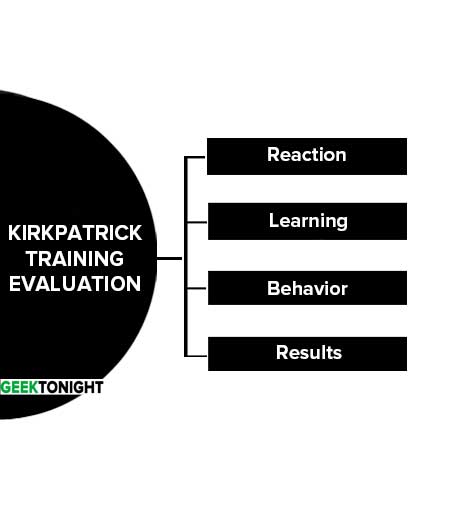Kirkpatrick Training Evaluation Model helps trainers to measure the effectiveness of their training in an objective way. The model was originally created by Donald Kirkpatrick in 1959 and has since gone through several updates and revisions.
Kirkpatrick Training Evaluation framework presents a model that health information management (HIM) instructors can use to improve upon the standard course evaluation form.
Evaluation of the impact and effectiveness of courses is necessary so that strengths and weaknesses can be identified and improvements made.
Kirkpatrick Training Evaluation
The Four-Levels are as follows:

Reaction
This level measures how the trainees (the people being trained), reacts to the training. Obviously, one want them to feel that the training was a valuable experience, and want them to feel good about the instructor, the topic, the material, its presentation, and the venue.
It’s important to measure reaction; because it helps to understand how well the training was received by the audience. It also helps to improve the training for future trainees, including identifying important areas or topics that are missing from the training.
Learning
In this level one measures what the trainees have learnt. How much has their knowledge increased as a result of the training? When the training session is planned, a list of specific learning objectives should be the starting point of the measurement.
The learning can be measured in different ways depending on these objectives and depending on whether you’re interested in changes to knowledge, skills, or attitude.
It’s important to measure what the trainees have learnt and what they haven’t. This will help in improving future training.
Behavior
At this level one evaluates how far the trainees have changed their behavior, based on the training they received. Specifically, this looks at how trainees apply the information. It’s important to realize that behavior can only change if conditions are favorable.
For instance, imagine you’ve skipped measurement at the first two Kirkpatrick levels and, when looking at a group’s behavior, it is determined that no behavior change has taken place.
Therefore, it can be assumed that the trainees haven’t learned anything and that the training was ineffective. However, just because behavior hasn’t changed, it doesn’t mean that trainees haven’t learned anything. Perhaps their boss won’t let them apply new knowledge. Or, maybe they’ve learned everything you taught, but they have no desire to apply the knowledge themselves.
Results
At this level, one needs to analyze the final results of the training. This includes outcomes that the organization has determined to be good for business, good for the employees, or good for the bottom line.
By going through and analyzing each of these four levels, one can gain a thorough understanding of how effective the training was, and how one can improve in the future.
Reference
- Kirkpatrick D. L. (1959). ‘Techniques for evaluating training programs.’ Journal of American Society of Training Directors, 13 (3): pp21–26.
Go On, Share & Help your Friend
Did we miss something in Marketing Management Tutorial or You want something More? Come on! Tell us what you think about our post on Sales Promotion | Marketing Management in the comments section and Share this post with your friends.
Human Resources Tutorial
(Click on Topic to Read)







